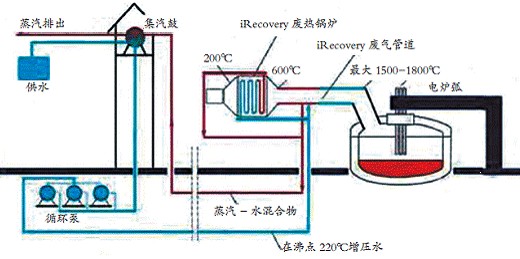Steel production process is long, the process and more, and mainly high-temperature smelting and processing, producing a lot of waste heat energy in the production process, all kinds of waste heat resources account for about 60% of the total production energy consumption. This article presents two new technologies for waste heat and waste gas recycling in the steel industry: the iRecovery EAF exhaust gas recovery technology and the GE gas turbine exhaust gas power generation technology.
1, Tenova company furnace flue gas waste heat recovery technology
Electric furnace input energy includes electricity, chemicals in natural gas, oil and carbon, etc., of which a large amount of energy is discharged with high temperature furnace flue gas. The high temperature flue gas generated by a 150 t / a electric furnace can generate 29 MW by using iRecovery technology. Tenova's iRecovery technology converts these high temperature flue gas waste heat to steam, but the specific use of the steam depends on the mill's process configuration. iRecoveryStage2 system flow shown in Figure 1.

Figure 1: iRecoveryStage2 system flow
The Tenova system uses a tube-to-tube heat exchange structure and working principle similar to a conventional heat recovery system that uses cooling water (20-40 ° C) to recover thermal energy from the furnace exhaust gas duct. The difference in operation is that iRecovery technology uses high-pressure and hot water (180-250 ° C) as the heat exchange medium to recover the heat of the high temperature dust-laden exhaust gas, thereby reducing the heat of the exhaust gas by evaporation. The first step is the use of radiant heat transfer at 600 ° C, and the second step is to recover the thermal energy at the inlet of the low temperature hot water with a waste heat boiler. High-temperature exhaust from electric furnaces carries dust, so special waste heat boilers such as waste incinerators must be used. Its key parameters determine the efficiency of the heat recovery system, such as the exhaust temperature at the outlet of the iRecovery system, the inlet temperature, and the volume of dilution air mixed with the exhaust before entering the iRecovery system.
From a theoretical economics point of view, power generation using iRecovery systems is not the best option, but it is the most viable option for other uses such as vacuum degassing, pickling, compressors, air conditioning, heating and oxygen generation. Steam turbines are most profitable if superheated steam can be produced continuously. Choosing the right boiler is an important factor if the steam can not be produced continuously. OrganicRankineCycle (ORC) boilers are best used because the latter can be enhanced by adding saturated steam or hot water Automatic stop and start.
2, Gas Turbine Exhaust Gas Generation Technology by General Electric Energy Corporation (GEEnergy)
GEEnergy will supply gas turbine equipment to a 170MW power plant in Handan Iron and Steel Company. Handan Iron and Steel Company in order to reduce energy costs, to achieve the 2015 emission reduction targets, decided to invest in starting the construction project. In the gas turbine combined cycle for electric blast furnace gas in the arts, coke oven gas generating system is an alternative to conventional combustion power boiler. The same fuel, GE9E gas turbine power generation and traditional boilers can be increased by more than 40%. This technology has great flexibility in the type of fuel used by steel mills and is very adaptable to changes in the amount of exhaust gas generated.
The gas turbines used in Handan include a GE9A5 generator, a large centrifugal compressor and a GEMarkTMVle controller that provide fully automatic control including fuel mixing, compression and cleaning, power generation using a mix of fuels, primarily low calorific blast furnaces Gas and coke oven gas. The system first processes the fuel, then pressurizes the fuel with a two-stage centrifugal gas compressor and purifies it with an electric precipitator. Large centrifugal compressors are rugged and require low maintenance when handling steel mills. Similar GE9E technology has been used in steelworks Corex exhaust generation, but also for Finex and other process exhaust generation.
Power plant emissions and steel mills are closely related to the amount of gas production. In addition to satisfying its own needs, a 3 million t / a steel mill process gas can also generate 170 MW of power plants. A 5 million t / a steel mill can generate electricity for a 210 MW plant. If the steel mills have more blast furnaces and coke ovens to ensure the normal operation of gas turbines, in case of major maintenance work can be replaced by natural gas.
Some mills use their natural gas and process gas to generate electricity for their own use and sell them abroad. By recycling their off-gas from their mills, they can become major power producers. For example, three power plants in Ilva, Italy, have been operating for 15 years, A total of 520MW.
Indexable Carbide Inserts For Spiral Planer
Indexable Carbide Inserts For Spiral Planer,Carbide Threading Inserts,Carbide Cutter Inserts,Carbide Insert Fly Cutter
SICHUAN TELOS NEW MATERIAL TECHNOLOGY CO., LTD , https://www.telosmaterial.com